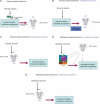TRPV4 plays an evolutionary conserved role in the transduction of osmotic and mechanical stimuli in live animals - PubMed (original) (raw)
Review
TRPV4 plays an evolutionary conserved role in the transduction of osmotic and mechanical stimuli in live animals
Wolfgang Liedtke. J Physiol. 2005.
Abstract
The TRPV4 ion channel, previously named vanilloid receptor-related osmotically activated channel (VR-OAC), functions in vivo in the transduction of osmotic and mechanical stimuli. In trpv4 null mice, TRPV4 was found to be necessary for the maintenance of systemic osmotic equilibrium, and for normal thresholds in response to noxious mechanical stimuli. In a Caenorhabditis elegans TRPV mutant transgenic for mammalian TRPV4, the mammalian transgene was directing the osmotic and mechanical avoidance response in the context of the ASH 'nociceptive' neurone. Molecular mechanisms of gating of TRPV4 in vivo are not known at this point and have to be determined.
Figures
Figure 1. Schematic drawings showing the specifics of signal transduction in sensory (nerve) cells in response to odorant (A), osmotic (B_–_C) and mechanical (D_–_E) stimuli
A, the odorant activates the TRPV ion channel via a G protein-coupled receptor mechanism. This happens, e.g. in the ASH sensory neurone of C. elegans in response to 8-octanone, an aversive odorant. The TRPV channel, OSM-9 or OCR-2, is down-stream of the G protein-coupled receptor. Calcium influx through the TRPV channel is an amplification mechanism which is necessary for this signalling pathway. B, one hypothetical scenario where, analogous to A, the TRPV channel functions down-stream of an – as yet unknown – osmotic stimulus transduction apparatus. Intracellular signalling via phosphorylation (dephosphorylation)-dependent pathways activates the channel. For heterologous cellular expression systems, two groups have obtained – contradictory – data that suggest phosphorylation of TRPV4 to be of relevance (Vriens et al. 2003; Xu et al. 2003). C, another hypothetical scenario where the TRPV channel is on top of the signalling cascade. Scenario I and II need not be mutually exclusive. Apart from phosphorylation of the TRPV channel, which could possibly be of relevance in vivo, a direct physical linkage of the TRPV channel to the cytoskeleton, to the extracellular matrix and to the lipids of the plasma membrane adjacent to the channel has to be considered. D, a hypothetical scenario re mechanotransduction. Here, an unknown mechanotransduction channel responds to the mechanical stimulus with calcium influx. This activity and the subsequent signal transduction are modulated by the TRPV channel. E, another hypothetical scenario re mechanotransduction. Here, the TRPV channel is the mechanotransducer itself. The data that we have obtained suggest the scenarios in C and E, whereas what happens in A does not happen when the OSM-9 channel is replaced with TRPV4 (Liedtke et al. 2003).
Similar articles
- Mammalian TRPV4 (VR-OAC) directs behavioral responses to osmotic and mechanical stimuli in Caenorhabditis elegans.
Liedtke W, Tobin DM, Bargmann CI, Friedman JM. Liedtke W, et al. Proc Natl Acad Sci U S A. 2003 Nov 25;100 Suppl 2(Suppl 2):14531-6. doi: 10.1073/pnas.2235619100. Epub 2003 Oct 27. Proc Natl Acad Sci U S A. 2003. PMID: 14581619 Free PMC article. - TRPV4 as osmosensor: a transgenic approach.
Liedtke W. Liedtke W. Pflugers Arch. 2005 Oct;451(1):176-80. doi: 10.1007/s00424-005-1449-8. Epub 2005 Jun 11. Pflugers Arch. 2005. PMID: 15952033 Review. - TRPV4 calcium entry channel: a paradigm for gating diversity.
Nilius B, Vriens J, Prenen J, Droogmans G, Voets T. Nilius B, et al. Am J Physiol Cell Physiol. 2004 Feb;286(2):C195-205. doi: 10.1152/ajpcell.00365.2003. Am J Physiol Cell Physiol. 2004. PMID: 14707014 Review. - Molecular mechanisms of TRPV4-mediated neural signaling.
Liedtke W. Liedtke W. Ann N Y Acad Sci. 2008 Nov;1144:42-52. doi: 10.1196/annals.1418.012. Ann N Y Acad Sci. 2008. PMID: 19076362 Review. - Transient receptor potential vanilloid channels functioning in transduction of osmotic stimuli.
Liedtke W. Liedtke W. J Endocrinol. 2006 Dec;191(3):515-23. doi: 10.1677/joe.1.07000. J Endocrinol. 2006. PMID: 17170210 Review.
Cited by
- The Multifaceted Functions of TRPV4 and Calcium Oscillations in Tissue Repair.
Jiang D, Guo R, Dai R, Knoedler S, Tao J, Machens HG, Rinkevich Y. Jiang D, et al. Int J Mol Sci. 2024 Jan 18;25(2):1179. doi: 10.3390/ijms25021179. Int J Mol Sci. 2024. PMID: 38256251 Free PMC article. Review. - TRPV1 (vanilloid receptor) in the urinary tract: expression, function and clinical applications.
Avelino A, Cruz F. Avelino A, et al. Naunyn Schmiedebergs Arch Pharmacol. 2006 Jul;373(4):287-99. doi: 10.1007/s00210-006-0073-2. Epub 2006 May 24. Naunyn Schmiedebergs Arch Pharmacol. 2006. PMID: 16721555 Review. - TRPV1: contribution to retinal ganglion cell apoptosis and increased intracellular Ca2+ with exposure to hydrostatic pressure.
Sappington RM, Sidorova T, Long DJ, Calkins DJ. Sappington RM, et al. Invest Ophthalmol Vis Sci. 2009 Feb;50(2):717-28. doi: 10.1167/iovs.08-2321. Epub 2008 Oct 24. Invest Ophthalmol Vis Sci. 2009. PMID: 18952924 Free PMC article. - TRPV4 Mediates Acute Bladder Responses to Bacterial Lipopolysaccharides.
Alpizar YA, Uvin P, Naert R, Franken J, Pinto S, Sanchez A, Gevaert T, Everaerts W, Voets T, De Ridder D, Talavera K. Alpizar YA, et al. Front Immunol. 2020 May 6;11:799. doi: 10.3389/fimmu.2020.00799. eCollection 2020. Front Immunol. 2020. PMID: 32435246 Free PMC article. - TET1-TRPV4 Signaling Contributes to Bone Cancer Pain in Rats.
Xu ZH, Niu Z, Liu Y, Liu PL, Lin XL, Zhang L, Chen L, Song Y, Sun R, Zhang HL. Xu ZH, et al. Brain Sci. 2023 Apr 10;13(4):644. doi: 10.3390/brainsci13040644. Brain Sci. 2023. PMID: 37190609 Free PMC article.
References
- Albers MA, Bradley TJ. Osmotic regulation in adult Drosophila melanogaster during dehydration and rehydration. J Exp Biol. 2004;207:2313–2321. - PubMed
- Bargmann CI, Kaplan JM. Signal transduction in the Caenorhabditis elegans nervous system. Annu Rev Neurosci. 1998;21:279–308. - PubMed
- Bourque CW, Oliet SH. Osmoreceptors in the central nervous system. Annu Rev Physiol. 1997;59:601–619. - PubMed
- Bourque CW, Renaud LP. A perfused in vitro preparation of hypothalamus for electrophysiological studies on neurosecretory neurons. J Neurosci Meth. 1983;7:203–214. - PubMed
- Brewster JL, De Valoir T, Dwyer ND, Winter E, Gustin MC. An osmosensing signal transduction pathway in yeast. Science. 1993;259:1760–1763. - PubMed
Publication types
MeSH terms
Substances
LinkOut - more resources
Full Text Sources
Research Materials
Miscellaneous
